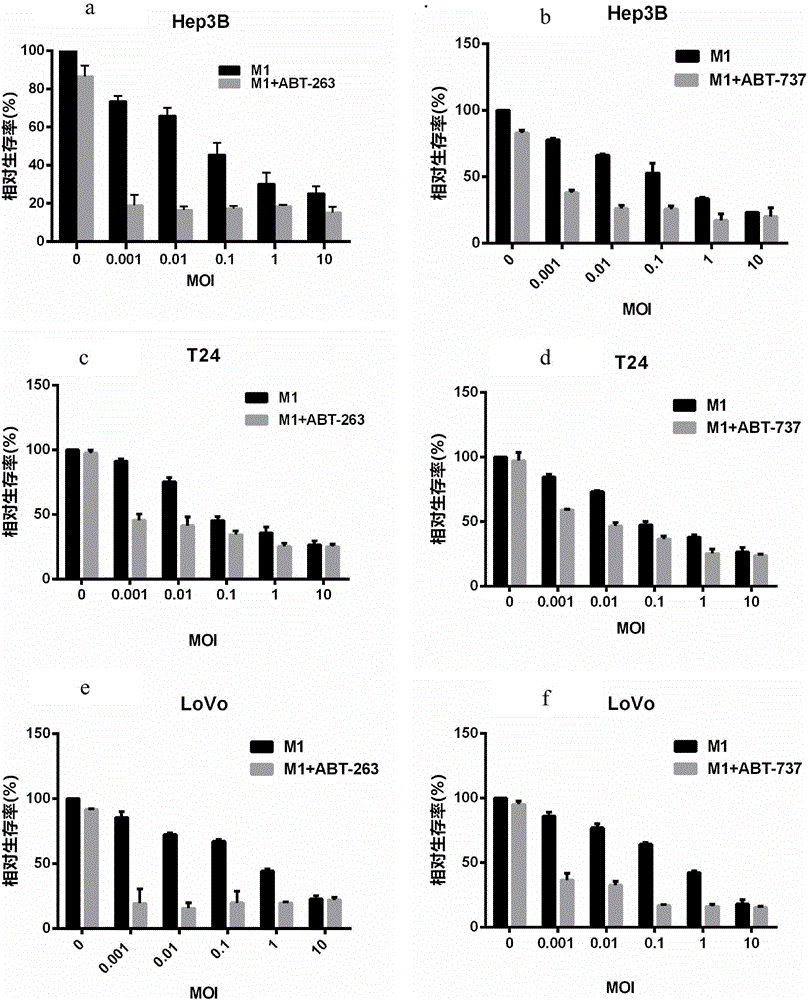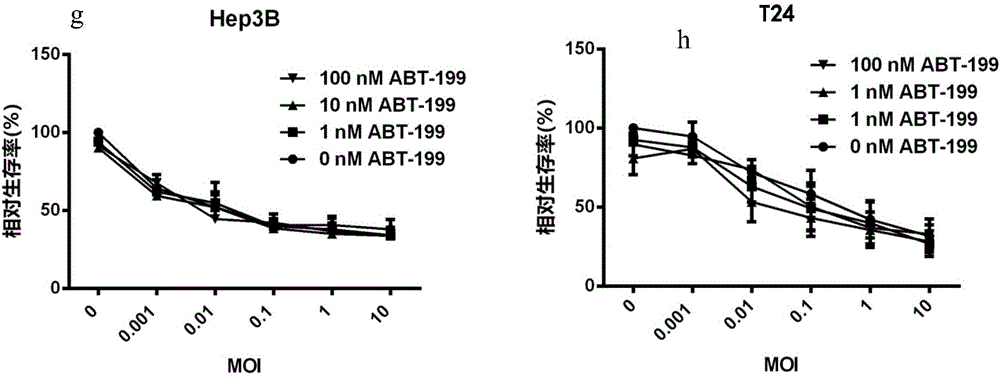Application of Bcl-xL inhibitor and oncolytic virus to preparation of anti-tumor medicines
An oncolytic virus and inhibitor technology, which is applied in the field of biomedicine to achieve the effects of increasing anti-tumor effect, enhancing inhibitory effect and improving therapeutic effectiveness
- Summary
- Abstract
- Description
- Claims
- Application Information
AI Technical Summary
Problems solved by technology
Method used
Image
Examples
Embodiment 1
[0049] Example 1 ABT-263 and M1 virus significantly increase the morphological lesions of human hepatocellular carcinoma lines
[0050] Material:
[0051] Human hepatocellular carcinoma Hep3B, M1 virus, high glucose DMEM medium, inverted phase contrast microscope.
[0052] method:
[0053] a) Cell culture: Human hepatocellular carcinoma Hep3B was grown in DMEM complete medium containing 10% FBS, 100 U / ml penicillin and 0.1 mg / ml streptomycin; all cell lines were placed in 5% CO 2 , cultured and subcultured in a closed incubator with a constant temperature of 37°C (95% relative humidity), and observed the growth with an inverted microscope. The cells were subcultured every 2-3 days, and the cells in the logarithmic growth phase were taken for formal experiments.
[0054] b) Cell treatment and morphological observation: cells in the logarithmic growth phase were selected, and DMEM complete culture medium (containing 10% fetal bovine serum, 1% double antibody) was used to make...
Embodiment 2
[0057] Example 2 Combined treatment of ABT-263 or ABT-737 with M1 virus significantly reduces the survival rate of human cancer cell lines
[0058] Material:
[0059] Human hepatocellular carcinoma Hep3B, human bladder carcinoma T24, human colorectal carcinoma LoVo, M1 virus, high glucose DMEM medium, automatic enzyme-linked detection microplate reader.
[0060] method:
[0061] a) Cell inoculation, administration treatment: select logarithmic growth phase cells, DMEM complete culture medium (containing 10% fetal calf serum, 1% double antibody) to make cell suspension, with 4 × 10 3 The density per well was seeded in a 96-well culture plate. After 12 hours, the cells were completely attached to the wall. The experiment was divided into control group, ABT-263 alone group, M1 infection group and ABT-263 / M1 combination group or ABT-737 / M1 combination group. The dose used is: M1 virus infects cells; different dose gradients are set for M1 virus.
[0062] b) Reaction of MTT wit...
Embodiment 3
[0067] Example 3 Inhibition of Bcl-xL synergistic anti-tumor effect of M1 oncolytic virus
[0068] Material:
[0069] M1 virus, human liver cancer cell Hep3B, bladder cancer cell T24, Bcl-xL and Bcl-w RNA interference fragments, MTT (methyl azolium blue), phase contrast microscope.
[0070] Bcl-xL interference fragment (Si RNA):
[0071] Sense strand (SEQ ID NO.1)
[0072] 5'-GGAUACAGCUGGAGUCAGUdTdT-3'
[0073] Antisense strand (SEQ ID NO.2)
[0074] 5'-ACUGACUCCAGCUGUAUCCdTdT-3';
[0075] Bcl-w interference fragment (Si RNA):
[0076] Sense strand (SEQ ID NO.3)
[0077] 5'-CAGCUGUAUUCCAUUACAUdTdT-3'
[0078] Antisense strand (SEQ ID NO.4)
[0079] 5'-AUCUAAUGGAAUACAGCUGdTdT-3'
[0080] method:
[0081] Select the cells in the logarithmic growth phase, prepare the cell suspension with DMEM complete culture medium, and use 1×10 5 seeded in 6-well plates. After 24 hours, add liposome-encapsulated Si RNA target gene fragments and infect M1 virus 24 hours later. 48 ho...
PUM
 Login to View More
Login to View More Abstract
Description
Claims
Application Information
 Login to View More
Login to View More - R&D
- Intellectual Property
- Life Sciences
- Materials
- Tech Scout
- Unparalleled Data Quality
- Higher Quality Content
- 60% Fewer Hallucinations
Browse by: Latest US Patents, China's latest patents, Technical Efficacy Thesaurus, Application Domain, Technology Topic, Popular Technical Reports.
© 2025 PatSnap. All rights reserved.Legal|Privacy policy|Modern Slavery Act Transparency Statement|Sitemap|About US| Contact US: help@patsnap.com



